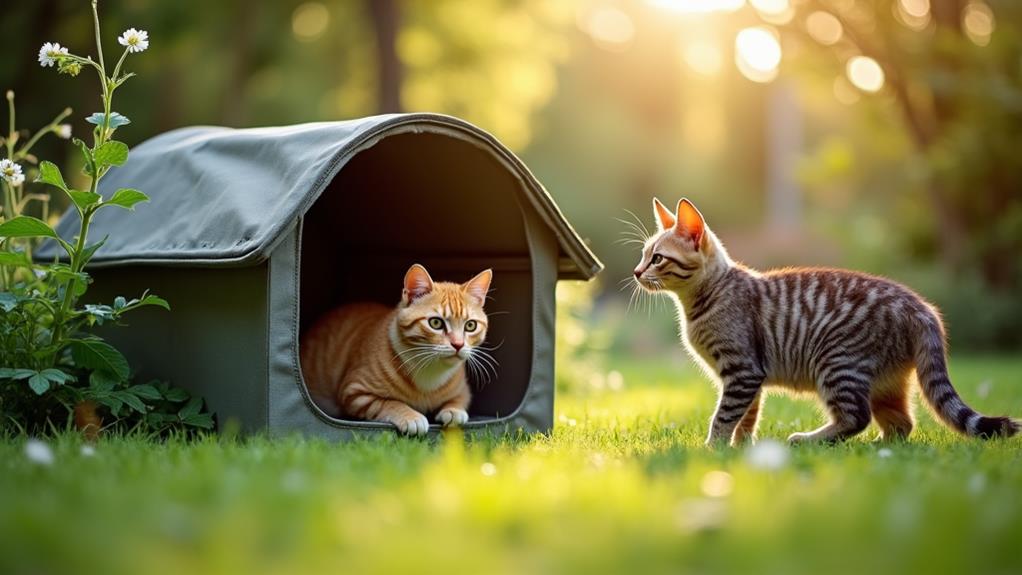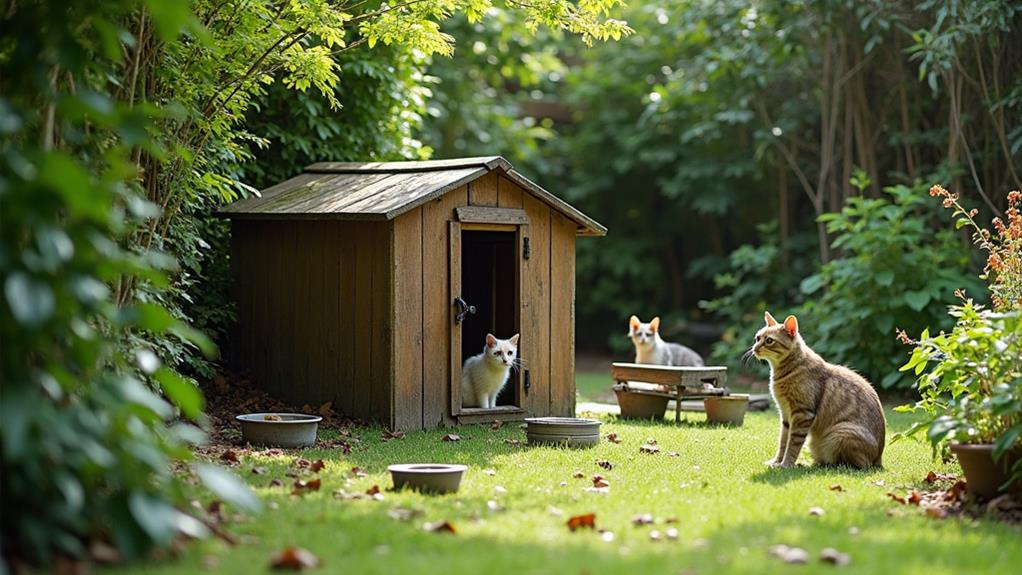How to Humanely Get Rid of a Feral Cat: Safe and Ethical Solutions

To humanely get rid of a feral cat, start with the Trap-Neuter-Return (TNR) method. Trap the cat using a humane trap, get it spayed or neutered, vaccinated, and then return it to its territory. This approach stops reproduction and helps manage the cat population ethically. You could also use deterrents like motion-activated sprinklers or natural scents such as orange peels to keep them away. Engage the community and partner with local shelters for support and resources. Ensuring ethical treatment not only aligns with animal welfare standards but also promotes responsible community engagement. Uncover more about effectively managing these wild companions further.
Understanding Feral Cats
Feral cats, which number between 60 million and 100 million in the U.S., are not socialized to humans and typically avoid contact, living in colonies without human intervention. Understanding feral cats is essential when considering how to address their presence in your area. These cats are the descendants of lost or abandoned domestic cats, and their population can grow rapidly. Female feral cats can become pregnant as early as 16 weeks old and have multiple litters each year, which can result in a single cat producing up to 420,000 offspring over seven years if not spayed or neutered.
The harsh reality is that feral cats often face difficult conditions, with an average lifespan of just 2-3 years. They encounter threats from disease, predators, and environmental hazards. Additionally, their presence can greatly impact local wildlife, as they are adept hunters. Helping feral cats through TNR programs is a recognized method to manage the feral cat population ethically. By having adult feral cats spayed or neutered, these programs aim to stabilize their numbers and improve their quality of life. In addressing feral cats, always consider the ethical treatment of animals in your approach.
Trap-Neuter-Return (TNR) Method
Understanding the behaviors and challenges faced by feral cats sets the stage for effective management strategies. One of the most humane methods to address these challenges is the Trap-Neuter-Return (TNR) approach. This method involves trapping feral cats, spaying and neutering them, vaccinating, and then returning them to their original location. By doing so, you help control the population without resorting to euthanasia, aligning with animal welfare principles.
TNR is essential because a single female cat can produce up to 420,000 descendants over seven years. Without intervention, overpopulation can spiral out of control. Furthermore, TNR programs don't just curb numbers; they improve the health of cat colonies:
- Population control: Spaying and neutering stops the cycle of reproduction.
- Disease prevention: Vaccines and sterilization reduce disease spread.
- Long-term effectiveness: TNR avoids the "vacuum effect" often seen with catch-and-kill methods.
- Community involvement: Local volunteers play significant roles in trapping, care, and education.
Your participation in TNR not only benefits the cats but also fosters community involvement and understanding. It's a compassionate, effective solution for managing feral cat populations while promoting animal welfare.
Effective Deterrent Techniques

When you're dealing with feral cats invading your garden or yard, employing effective deterrent techniques can be a game changer. These techniques help you maintain your space without unnecessary human contact or harm to the animals. To start, you can repel feral cats using natural scents. Scatter orange peels or vinegar around your garden. Their strong scents serve as a humane solution to discourage cats from entering your space.
Another effective method is installing motion-activated water sprinklers like CatStop. These devices scare away feral cats by squirting water when motion is detected, providing a humane and surprising deterrent. For a physical barrier, consider using plastic carpet runners with the spiked side up. They create an uncomfortable surface, discouraging cats from digging in your flower beds.
Embedding wooden chopsticks or pine cones in the soil can also act as a physical barrier, preventing cats from disturbing your garden. Moreover, ultrasonic animal repellents can be a great option. They emit high-frequency sounds that feral cats find unpleasant, thereby deterring them without causing harm. These deterrent techniques offer effective, humane solutions to manage feral cat presence in your garden.
Community Involvement and Education
While effective deterrent techniques can help manage feral cats in your garden, involving the community can bring sustainable solutions. Community involvement is essential for the success of Trap-Neuter-Return (TNR) programs. By participating actively, you can help guarantee consistent care and monitoring of feral cat populations. Educational initiatives play an important role in raising awareness about TNR's benefits. Imagine, a single unspayed female cat can produce up to 420,000 descendants in just seven years! That's where education comes in, reshaping public perception.
Here's how you can get involved:
- Partner with Local Organizations: They often provide resources, training, and support, fostering responsibility and stewardship toward feral cat populations.
- Engage with Veterinarians and Animal Shelters: Collaborate to access low-cost spay/neuter services, making humane feral cat management more accessible.
- Participate in Community Outreach: Help shift public perception, promoting compassion and encouraging responsible actions that benefit both cats and local wildlife.
- Attend Workshops and Seminars: Learn more about TNR and other humane strategies, enhancing your ability to contribute effectively.
Managing Outdoor Cat Colonies

To effectively manage outdoor cat colonies, implementing Trap-Neuter-Return (TNR) programs is vital, as they greatly curb reproduction rates and improve the cats' health. By neutering feral cats, you reduce the number of stray cats and guarantee that the ones in the managed colony live healthier and more stable lives. Feeding the cats on a regular schedule and managing waste properly is fundamental for cleanliness and minimizing conflicts with neighbors.
Designating caretakers for the managed colony guarantees that feral cats receive necessary veterinary care and consistent nourishment. This organized approach not only improves the well-being of the cats but also helps maintain harmony within the community. Community involvement plays a significant role in this process. Educating residents about humane practices and feral cat management fosters a sense of responsibility and encourages support for TNR efforts.
Collaborating with local veterinarians and animal shelters can provide valuable resources and support. These partnerships can aid in the sustainable management of feral cat populations, promoting humane practices across the board. By taking these steps, you can manage outdoor cat colonies effectively, guaranteeing a balanced and compassionate approach to controlling stray cat populations.
Health and Safety Considerations
Dealing with feral cats involves several health and safety factors that shouldn't be overlooked. Feral cats can carry infectious diseases like toxoplasmosis and feline leukemia, posing health risks to humans and other animals. To mitigate these risks, guarantee proper vaccination and health checks for the cats before any interaction. One effective strategy is the Trap-Neuter-Return (TNR) program, which helps control overpopulation by spaying or neutering feral cats. This approach not only reduces the competition for resources but also minimizes potential health issues.
Here are some key points to take into account for safe and humane management:
- Vaccination and Health Checks: Always prioritize these to reduce health risks and guarantee safe interactions with feral cats.
- Implement TNR Programs: These effectively control feral cat populations, addressing health issues related to overpopulation.
- Maintain Clean Feeding Areas: Clean conditions deter pests and prevent disease spread among cats and local wildlife.
- Community Education: Educate residents about feral cats' health risks and promote humane management for safer community interactions.
Regularly monitor feral cat colonies to manage health issues like fleas and parasites, safeguarding both the cats and the environment. With these practices, you can foster a healthier coexistence between feral cats and your community.
Legal Compliance and Guidelines

Understanding the legal landscape is vital when managing feral cats. You need to familiarize yourself with both federal and state legislation to guarantee legal compliance and humane treatment in your feral cat management efforts. Key resources, like the National Code of Practice, emphasize ethical pest control methods, which you must follow in any strategy you adopt.
Local regulations can vary, so it's important to check with local authorities before taking action. They might require permits for certain control methods. Trap-Neuter-Return (TNR) is a widely recognized and humane approach, often supported by community organizations and veterinarians. TNR aligns well with legal compliance, as it focuses on controlling the population without harm.
Additionally, resources such as the PestSmart initiative offer guidelines on acceptable control methods, helping you confirm your practices meet legal standards. Engaging with community organizations and collaborating with veterinarians can provide valuable insights and support, guaranteeing your efforts are both legally compliant and ethically sound. By following these guidelines, you contribute to a humane and effective solution for managing feral cats, respecting both the law and the well-being of the animals.




